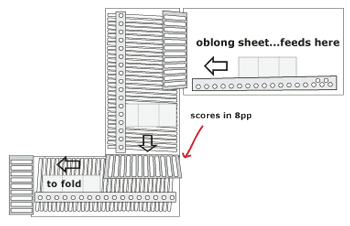A previous Bindery Success blog article discussed tips on getting better register when running oblong sheets. This next technique was submitted to our Bindery Success newsletter by Martin Smith of The Journeyman Press in MA.
 According to Smith, “On most folders you’ll find it easier to hold the score in the 8pp unit vs. the parallel section. This is due to the cross carrier rollers. In the first unit the only thing holding the sheet in the guide are the marbles in the side-guide. In the 8pp you not only have the marbles, but you have all of the cross carrier rollers turning with the sheet as well. It’s certainly not unheard of to achieve a ratio of 4 to 1 (sheet length to width) with this method.
According to Smith, “On most folders you’ll find it easier to hold the score in the 8pp unit vs. the parallel section. This is due to the cross carrier rollers. In the first unit the only thing holding the sheet in the guide are the marbles in the side-guide. In the 8pp you not only have the marbles, but you have all of the cross carrier rollers turning with the sheet as well. It’s certainly not unheard of to achieve a ratio of 4 to 1 (sheet length to width) with this method.
By scoring in the 8pp unit you gain in a few areas:
First, it makes it much easier to feed. A less experienced operator can get the job done well.
Second (and most importantly) you’ll find it holds the score like a rock.
Third, if you have one of your folders set up for 16 pagers most of the time it’s a short changeover.”
A Production Strategy for Oblong Folds
Instead of wasting valuable folding machine time re-learning whether or not an oblong sheet will run, set aside time to create a standard for such jobs. You’d only have to do it once. (Yes, I know that in the real world there are always exceptions!)
A limiting ratio (Long side ÷ Short side = Ratio) as mentioned above could be used to make a determination by setting a go/no-go limit for running the job entirely on the folder. Maximum and minimum sheet sizes will also help. Then, using the folder techniques discussed here and in the previous article, experiment with different sizes, ratios and paper stocks.
For the sake of illustration, let’s say that the best you can do and still get good register is a sheet that has a 2.3 to 1 ratio (e.g. a 25.5” x 11” sheet.) If you get a job that is 29” x 11” (29÷11 = 2.6) then you know before it ever gets to your folder that it should be scored in a separate operation.
The point is that you would know in advance. Then you can plan and bill accordingly without wasting valuable machine time every time an oblong job comes in.
So now you have some interesting folding machine techniques to try. Spend a little down time creating your folder’s operating standard and in the long run you’ll save countless hours of bindery production time and probably a little frustration, too!
As always you're welcome to share your experiences and suggestions below!

